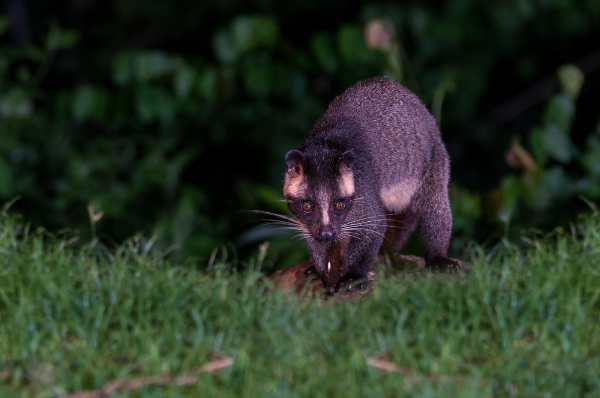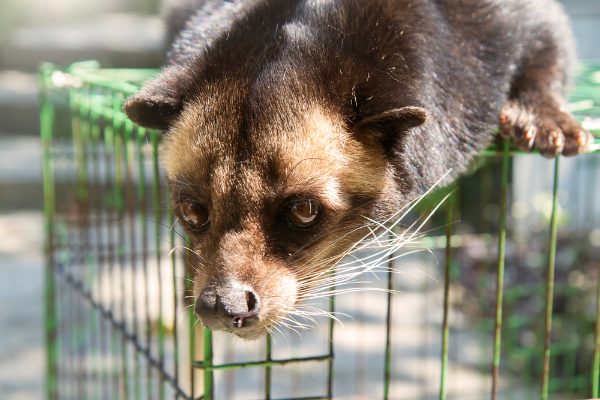The masked palm civet (Paguma larvata) is one of the most elusive and fascinating members of the cat family. With its mask-like markings and propensity for living in dense, tropical rain forests, this shy creature is seldom seen by humans. In this blog post, we’ll take a closer look at the masked palm civet, including its physical characteristics, behavior, diet, and conservation status. We’ll also explore some of the myths and legends that have been associated with this enigmatic animal. So read on to learn more about the masked palm civet!

Masked Palm Civet Description
The Masked Palm Civet is a small to medium-sized mammal native to Southeast Asia. The civet has a long, lithe body with short legs and a long tail. It is heavily built and has a thick coat of fur that is usually grey or brown in color. The civet’s most distinctive feature is its black mask, which extends from the top of its head to its nose. Masked Palm Civets are nocturnal animals and are primarily arboreal, meaning they live in trees. They are excellent climbers and are capable of hanging upside down from branches. Civets are omnivorous animals and their diet includes fruits, insects, small mammals, and reptiles. Masked Palm Civets are solitary creatures and typically only come together to mate. They are listed as Least Concern by the IUCN Red List and have a wide range of habitat throughout Southeast Asia.
Masked Palm Civet Habitat
Masked Palm Civets are found in a variety of habitats, including forests, woodlands, and scrublands. They are most common in primary forests, but can also be found in secondary forests, logged forests, and even in urban areas. Masked Palm Civets are generally shy and reclusive animals, but they have been known to approach people in search of food. Masked Palm Civets are active both during the day and night, but they are more likely to be seen during the twilight hours. Masked Palm Civets are solitary animals, but pairs or family groups have been known to share a home range. Masked Palm Civet habitat requirements include access to water, trees for climbing, and dense understory for hiding. Masked Palm Civets are not currently considered to be at risk of extinction. However, their habitat is threatened by deforestation and conversion of forest to agricultural land. Masked Palm Civets are protected by law in some countries, but more needs to be done to protect their habitat.
Masked Palm Civet Diet
The Masked Palm Civet is a small, nocturnal mammal found in Southeast Asia. Their diet consists primarily of insects and fruits, but they have also been known to eat small mammals, reptiles, and eggs. In most cases, the Masked Palm Civet will choose to eat soft-bodied insects, such as beetles and caterpillars. They are also particularly fond of honey, and will often raid bee nests in search of this sweet treat. While the Masked Palm Civet is not a threat to human beings, they can be a nuisance to farmers and gardeners who find their crops ravaged by these voracious eaters.
Masked Palm Civet Size
Masked Palm Civets are small to medium-sized mammals that are found in tropical forests across Southeast Asia. They get their name from the black markings around their eyes, which resemble a mask. Masked Palm Civets are nocturnal animals, and they spend most of their time high up in trees. They are excellent climbers, and they have sharp claws that help them to grip onto branches. Masked Palm Civets are also very good swimmers. They usually weigh between 5 and 7 pounds, and they range in length from about 15 to 20 inches. Masked Palm Civets are an important part of the forest ecosystem, and they play a role in seed dispersal and pollination. They are also hunted for their meat, which is considered to be a delicacy in some cultures. Masked Palm civets are generally shy animals, but they can be aggressive if they feel threatened. If you ever have the chance to see one of these amazing animals in the wild, you will be sure to be impressed by its size and beauty.

Masked Palm Civet Lifespan
The Masked Palm Civet is a small carnivorous mammal native to Southeast Asia. It is a nocturnal creature that typically inhabits dense forests. The Masked Palm Civet is easily distinguished by its black fur, which is dotted with white spots. It has a long prehensile tail and a long, slender body. The Masked Palm Civet typically has a lifespan of 10-12 years in the wild, though captive individuals have been known to reach 20 years of age. The Masked Palm Civet is an opportunistic feeder and its diet includes fruits, vegetables, small mammals, and insects. It is an important species in the forest ecosystem, as it aids in seed dispersal and insect control. Though its populations are currently stable, the Masked Palm Civet is listed as “Near Threatened” by the IUCN due to habitat loss and hunting pressure.
Masked Palm Civet Behavior
Masked Palm Civets are a species of civet native to Southeast Asia. They are nocturnal animals and prefer to live in forests. Masked Palm Civets are solitary creatures and only come together to mate. They are omnivorous, eating both fruits and small animals. Masked Palm Civets are also known to eat coffee beans, which is how they got their nickname ‘coffee civets.’ These animals are important in the coffee industry because they help to spread coffee trees. Masked Palm Civets have a long body, a bushy tail, and black fur with white markings around their eyes and mouths. Their name comes from their habit of wearing leaves around their necks, which they use to camouflage themselves from predators. Masked Palm Civets are shy animals and are rarely seen by humans. However, they are an important part of the ecosystem and play a role in seed dispersal and pollination.
Masked Palm Civet Speed
The Masked Palm Civet is a small mammal native to Southeast Asia. It is a member of the civet family, and is closely related to the Asian Palm Civet. The Masked Palm Civet is distinguished from its cousin by its black fur, which is patterned with white spots. The Masked Palm Civet is an agile creature, and is capable of running at speeds of up to 30 kilometers per hour. In addition to its speed, the Masked Palm Civet is also known for its craftiness. It is an expert climber, and is often seen scaling trees in search of food. The Masked Palm Civet is a nocturnal animal, and spends most of its time hunting for insects, small reptiles, and other animals.
Masked Palm Civet Hunting
Masked Palm Civets are small, nocturnal animals that are found in tropical forests across Asia. They are highly sought after by hunters due to their valuable body parts, which are used in traditional Chinese medicine. Masked Palm Civets are also hunted for their meat, which is considered a delicacy in some cultures. The hunting of Masked Palm Civets is having a devastating impact on populations of these animals, and it is estimated that they could become extinct within the next 20 years. Masked Palm Civets are just one example of the many animals that are being hunted to the brink of extinction. The international wildlife trade is worth billions of dollars each year, and it is one of the biggest threats to biodiversity on the planet. If we want to protect vulnerable species like the Masked Palm Civet, we need to put an end to the illegal wildlife trade.
Conclusion
The masked palm civet is an interesting creature with a unique biology. It is important to understand the habits and ecology of this animal so that we can better protect it from extinction.
Frequently Asked Question

